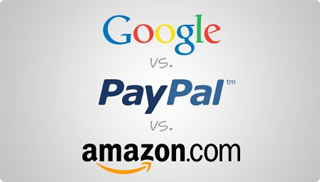How to Scale Your Business: From One to Many
A Fireside Chat via Google Hangout
Hosted by

How to Scale Your Business: From One to Many
As your startup or small business hits its first big growth spurt, scaling gracefully can be a tricky maneuver. You need to continue serving your current clients and doing what works, but you need to plan your finances and marketing for bigger projects and bigger audiences at the same time.
Business speaker and NY Times columnist Jay Goltz cites “out-of-control growth” as one of the top 10 reasons that small businesses fail. Mike Kamo, business writer and VP of Marketing, ups the ante by listing “rapid growth and over-expansion” as one of six reasons that small businesses bomb.
Growth is an exciting season, but it doesn’t mean you’re out of the woods just yet. Managing growth well is as important as the day you opened your doors.
From funds, to communications, to expanding your team, running a small business is not the same as running a startup. If you can look ahead and plan as well for the next stage of your business as you did for the first, though, you’ll be in good shape to stand out from the crowd and be the one that makes it big.
How to Finance Your Growing Small Business
Your finances are constantly evolving. From initial projections when you opened your doors, to adjusting for the real-world market, to financing growth, you are never done budgeting and calculating. As your business grows, three big considerations about the books will demand your attention.
1. Adjust Your Budget: 3 Steps to Savvy Finances
If you’re considering the How To’s of scaling, business is good. Momentum is building and marketing share is growing, but before you start the next big thing take some time to go over that budget. It’s less exciting than revolutionizing your industry or changing lives in your growing audience, but fine-tuning the budget for the next season is crucial to both (and more).
Hopefully you put together an estimated budget when you started the business, and that means you won’t be starting from scratch. Compare your initial projections for sales/profits, operating expenses, and gross profit margins with what has actually happened so far. Use that reality to adjust your budget for the next 12 months. Err on the side of caution.
I find that even when business owners have a plan written down, they are often a little aggressive in the 12- and 24-month period. They start out with the best-case scenario, and they overstate their success. One of the biggest challenges that an entrepreneur has is bringing it back and making it realistic.- Rod Woodcock, President and Founder, The Alternative Board Fraser Valley
Whether you’re finally creating your first budget, or adjusting the initial one for your new season of growth start by projecting sales and profits:
- Project sales and profits—If this is your first budget, estimate a reasonable profit for the coming year. If you have records, pull last year’s profit statement and use that to estimate your sales target for the coming year.
- Estimate expenses—Fixed expenses will be easier to assume than variable expenses if you’re starting from scratch. Consider salaries and wages, rent, utilities, taxes, supplies, etc.
- Calculate gross profit margin—Subtract the cost of goods (inventory, shipping charges, etc.) from your profit target.
The estimated gross profit margin will let you know if you need to wait on some purchases, or change your plans to push for more sales. You can download an editable budget worksheet from SCORE to help develop your budget.
2. Set Your Salary: Three Reasons to Pay Yourself Now
As a new startup owner you probably haven’t been taking much of an income from the business, and you may not have been planning to do so for a while.
Pay yourself as little as you need to focus on the business and cover your expenses. Early on there’s just such a high probability that your business won’t succeed, and any money you take out of the business is money that you’re not investing in growth or continuing to run the business.- Bhavin Parikh, Co-Founder and CEO, Magoosh
But as the business grows and you start to look ahead, there are three big reasons why budgeting even a modest, token salary for yourself is a good move.
First, taking a salary will inspire you to earn more with your business. It feels like you’re doing everything you can to grow your business, but you might be surprised how much wiser you become when there’s a paycheck on the line.
Remember that you’re going to have to force yourself to pay yourself some money at some point, even if you’re bootstrapping. What that will do is that’s going to give you the boost, the impetus, to actually earn more in your business. I’m a big believer in goals, and if we set goals we have a tendency to achieve goals. If we don’t set goals we’ll just drift.- Anita Campbell, CEO, Small Business Trends
Second, forcing yourself to take a salary will also incentivize you to fix problems quickly.
One of our first employees was very distracted, very unproductive—to the point where my wife and I were withholding from cashing our own paychecks. They would just sit on the kitchen counter waiting for everyone else to cash their paychecks. That was such a pain point for us that we never wanted to go back there again. So I think when you start to pay yourself, you really feel the pain when something isn’t going well.- David Ciccarelli, CEO, Voices.com
Finally, showing a salary for the CEO—even a humble one—on your books is evidence to investors and partners that you’re not just throwing money at a hobby.
It may not be market-based pay, but eventually you need to start getting that compensation up there. If you’re looking at going out and getting financing through other sources they’re going to look at that. The reality is that the longer the track record shows that the company is able to pay out a competitive pay to the person who is running it, the better it looks for the business on the books. Are you truly profitable, or are you just showing profit as a company because you’re not paying wages out to the owner? Because that’s a fallacy.- Rod Woodcock
At the very beginning, you may not be able to pay yourself anything, and that’s normal. But whether or not you need the income, set a goal for which year you are going to start taking a salary, and then take it—even if it’s just a few hundred dollars each month. If growth happens faster than you planned, take it sooner. It’s not necessarily for you: it’s a savvy business move.
3. Secure Funds for Growth and Sustainability
Covering current expenses and keeping your accounts in the black, while securing extra funds for growth and scaling efficiently with those new resources, can be a balancing act. Secure financing from the right source and using what you have wisely are two factors that make or break many small businesses during a period of growth.
Some of the possible sources for financing include:
- Friends and family
- Crowdfunding
- Startup competitions and grants
- Loans
- Angel investors and venture capitalists
Which one is best for your business in its present stage of growth will depend on several factors.
If you read the news you’d think that every business out there is crowdfunding their business now, but this is still such a small slice of financing for startups. It’s only appropriate for very, very specific types of products, and certainly not most services. The one area where I’d look to crowdfunding is if I had some sort of consumer product, and I’d look at it more as testing the marketing to see if I could generate interest. That would be a good indication that maybe people will buy the product, but even after that I’d look elsewhere for startup financing.- David Waring, Co-Founder and Editor, Fit Small Business
Once you have funding for your next stage of growth, use it wisely. Create a micro-budget for the next stage of growth—gather all the expenses and project realistic sales/profits—and make sure your extra resources fit into the plan.
And before you make your first move, consider the annual cycle of your business and/or industry.
When it comes to growth and sustainability, the most important thing is to really understand your finances. The more you know about your business, the better prepared you can be. You may have a big influx of sales and feel like it's the right time to make a big purchase, only to realize that your slowest season is just a month away.- Sara Rosenfeld, Product Marketing Manager, Wave
With appropriate financing, a budget for scaling, and a thorough understanding of your business forecast, you will be ready to ride the wave of momentum you have built without getting tossed around by it.
More Resources for Small Business Finances
- The Business of Bad Credit: 14 Dos and Don’ts for Small Business Owners
- Financing a Small Business: How Do You Secure the Funds?
- Small Business Loans: 6 Myths Debunked
How to Market Your Business to Grow Sales
When you were bootstrapping your startup you leaned heavily on word-of-mouth marketing strategies—referrals, social media, review sites, etc. But now that you’re running a growing small business, your marketing strategy needs to change with your budget and goals.
As you expand your marketing strategy, make sure to consider what speaks to your audience and your business model.
If you have a physical location, investing in a great sign outside your location is going to be very meaningful. The product or service matters—if it’s online or offline that is ultimately going to determine where to spend your money. If you have an offline business, advertise offline. If you have an online business it makes more sense to spend money on Google AdWords. Match up your offer with the channel where you’re ultimately doing business.- David Ciccarelli
1. Increase Exposure with SEO
You probably launched with a website, but now is the time to make sure it’s ready to scale with you and to invest in some good SEO if you haven’t already.
In this day and age your business card is your website. If you’re not selling through your website that’s fine, but it still needs to look professional. Everyone is going to go take a look. One of the best things I’ve seen taking place is this wake up to SEO.- Rod Woodcock
@Grasshopper #LocalSEO is a must! Use Moz Local to help add your hours, business phone number, and website across the web! #frsdchat
— Greg Kristan (@GregKristan) March 24, 20152. Get More Referrals
Although your marketing budget is expanding, word-of-mouth will always be the most effective channel. Keep exceeding expectations, and providing customers with very easy ways to share their experience of your brand with their friends and networks.
The importance of customer referrals cannot be understated. Always go above and beyond what you promise to deliver to customers, and then implement a client referral program. My existing clients who refer business get a referral bonus, and the new client they refer gets a discount on their first month of service. It’s so simple and so effective.- Blair Nastasi, Media Moguls PR
I typically ask people for referrals directly, and the best way to increase referrals is to give more value than you take and exceed customer expectations.- Catherine Marsden, Ardent Scope Marketing
Three ways to get more referrals:
- Ask … a lot. Ask happy clients and customers while you are still actively engaged in business. And don’t be nervous about it. You’re not asking because you’re desperate and needy, you’re asking because you do good work and you want to help their colleagues.
- Make it easy. Add a link on your website, your social profiles, your email marketing campaigns, etc. You could also send your clients a sample referral email for them to use for connecting you with their friends.
- Refer your clients. Your clients are likely in business too. Connect them with qualified prospects that you know, and refer them whenever you can.
Referrals are the lifeblood of your business, and it’s okay to say so. If your clients are happy, they’re usually more than happy to refer you, but people get busy and they need some reminders.
3. Improve Market Share by Networking
As you continue to build a name for your brand, networking—both online and offline—is key, especially for B2B brands. Attending industry events is a great way to network and drive business in the real world, and connecting or partnering with compatible software brands is the new face of networking online.
For B2B services, engaging your community through conferences and events can be very powerful. You don't even have to exhibit, just attend and make connections with growing companies that mesh with what you provide. I attended web hosting conferences where there were many companies that sold server equipment but no support. We struck simple agreements that drove 80% of our growth for the first three years we were in business. After a couple of years, I even was invited to speak.- Jeffrey Huckaby, CEO and Founder, rackAID
If you are doing any kind of software or B2B services, don’t overlook partnerships. If you can get listed in an app store of another, bigger, better-known application or software platform, whatever makes sense for your business, make sure you’re listed in that. Also, offering integrations today is really key if you have any kind of software. Again, very often, there will be some sort of directory that has applications listed that one application integrates with. Make sure you integrate and that you’re somehow connected with these other apps.- Anita Campbell
Some of your customer referrals may even open doors for you to attend events or connect with other brands in your industry.
4. Manage Your Online Reputation with Digital Marketing
Most modern entrepreneurs and small business owners don’t need to be told that online marketing is important. But with a growing business to run, and a rapidly changing digital landscape, keeping up can be tough for even the most savvy. There are four main pillars of modern, online marketing:
- SEO
- Content marketing
- Social media
- Influencer marketing
There is a lot of overlap, obviously, so a good digital marketing strategy will include all four.
SEO is important, but too time-consuming for a lot of business owners. Make sure your first marketing hire knows SEO, or consider outsourcing it. In the meantime, try a depersonalized search for your brand and a few of key phrases and see what comes up.
Go onto Google, look for your business, and see what’s showing up. It may be Yelp! reviews, it may be CitySearch, etc. Start by fixing those things.- David Waring
Content marketing isn’t the new kid on the block anymore, which means your competitors may be doing it, but it also means your audience is probably expecting it.
Information is the key, not advertising. Advertising is even harder than in the past. Your focus should be on informing and educating your consumers. Provide the same information that they would get in-person, yet to a larger audience.- Jon Zack, EggZack
Social media is a very important marketing outlet for a lot of small businesses, but your social strategy should mature with your brand.
I grow my small business by networking one-on-one with individuals first, and then I use social media to support my face-to-face communication. For example, I may add a person I met at a networking event to my email list, send them a blog post they might like, or connect with them on LinkedIn.- Catherine Marsden, Ardent Scope Marketing
Influencer marketing should look like networking from the outside, but be treated like marketing from the inside.
I realized I can either market to 10,000 potential customers, or I can build relationships with four or five influencers who already have clout with 20,000 customers. The answer was a no brainer.- Blair Nastasi, Media Moguls PR
SEO and content marketing should always be done hand-in-hand. Social is going to play a big part in your content strategy, and it’s also a great way to reach out to influencers.
5. How to Measure Your Marketing ROI in 1 Easy Step
There are a lot of great tools for marketing metrics. Google Analytics is one to start familiarizing yourself with, if you’re not already, for tracking all kinds of information about clicks, goals, referrals, etc. online.
But it’s also true that channels get crossed and sometimes combined. The very best way to figure out where your qualified leads are coming from, and what marketing strategies are producing the best return, is to ask.
One thing that has worked really well for us is testing different channels but then asking all of our paying customers, “Where did you hear about us?” You can install fancy analytics packages, but sometimes people will watch a YouTube video and then go to Google and type in our name. There’s no way to track them across the web, but when we ask and they tell us, “YouTube,” we know we can keep investing in YouTube.- Bhavin Parikh
That ask can be a simple form field in front of some gated content, part of your standard sign-on procedure, written into the script for a certain follow-up call, etc. There are a lot of seamless ways to work it in, and it will reap very actionable insights.
6. Future-Proof Your Marketing with Mobile
Mobile internet usage is growing exponentially, causing brands and businesses of all shapes and sizes to update strategies for SEO, content, ads, social, and more. Consider:
- 80% of users search the internet from their smartphones.
- 90% of executives use mobile to research business purchase.
- Mobile internet usage has exceeded desktop since January 2014.
Mobile is just mandatory. It’s a checkmark that has to be there.- Rod Woodcock
A year ago, a mobile-friendly website was a big bonus for a brand. Today it’s no longer an option.
More Resources on Marketing Your Small Business
- Creating a Referral Engine: What Are Some Methods You’ve Used?
- Does Your Business Need Content Marketing?
- No Advertising Money? Here Are 10 Helpful Solutions
How to Know When It’s time To Grow Past A Company of One
Each one of the first few hires in a growing small business can be an exciting yet stressful experience. With the right goals in place, however, you can make sense of your options and be sure to build the right team.
1. Create Goals and a Timeline to Achieve Them
As you’re considering whether or not it’s time to add a new team member, make sure, first, that your goals are strategic and clear.
Make your goals very measurable, and say “We’re trying to hit X-million in revenue, or a certain net promoter score,” rather than creating projects. Because it’s unclear whether the projects will tie to the metrics that actually make your business succeed.- Bhavin Parikh
In addition to making them measurable, make sure your goals are helping you measure the things that are important—like your bottom line.
One of the key issues I see is not making your goals specific enough for revenue, broken down according to daily and weekly goals at least.- Anita Campbell
Remember that goals in your head are not as effective as goals that are in front of you all the time. Write them down and keep them where they can watch over you as you work toward them.
A1: @davidciccarelli says to actually write your goals down on paper. "Create a living document that you can update all the time." #frsdchat
— Grasshopper (@Grasshopper) March 24, 20152. Consider Outsourcing Instead of Hiring
There is a lot of freelance talent on the market, and it has changed the way many small businesses scale.
Hiring employees changes your work from doing what you love to managing others. You can grow two ways: outsourcing work that you do yourself inside the company (social media, web management, finances and bookkeeping, marketing, etc.), or through collaboration. Find other like-minded solopreneurs, and together pursue larger projects and larger jobs. This requires lots of communication, sharing of resources, and some vital project management skills, but it is a way to temporarily scale your company to take advantage of opportunities when they arise instead of committing yourself to long-term, fixed overhead that will remain in place even when you do not have the volume to support it.- Jackie Peterson, Better, Smarter, Richer
Some situations call for outsourcing, and some do not. If you need to bring in skills that don’t exist on your team, for example, outsourcing is a great option.
it’s interesting that we automatically think of outsourcing as taking a position and bringing someone in to do it. We find that a lot of small companies can bring expertise in if they look to outsource something that didn’t even exist.- Rod Woodcock
If you find yourself considering a new hire, take a minute to ask yourself if you need to fill a position or complete a project. Outsource projects and hire for positions.
A3: Agree @davidciccarelli. I see too many entrepreneurs hire full-time people for project-based positions. #frsdchat
— Taylor Aldredge (@tayloraldredge) March 24, 2015In addition to long-term positions, never outsource tasks that are core to your business or things that—for whatever reason—you just like to do.
When we originally started our site, we thought we would be able to outsource our content because there are so many writers out there looking for work. What we actually found was it’s very difficult to find writers who produce high-quality content, and it’s so core to our business that we couldn’t sacrifice there. So we kind of did a 180, and went from using 100% outsourced writers to hiring our own full-time writers in-house. I think you have to really figure out what your core value proposition is, and make sure that you hire the people doing that work.- David Waring
Not to make light of the situation, but is it something that you enjoy doing, or is it something you can’t stand? If you really love designing graphics, even though you might be on an ecommerce site, for example—if it drives you, consider continuing doing that. If there’s other stuff that you dread doing, then that’s an easy decision.- David Ciccarelli
Ready to outsource some work? Here are some great resources:
- Elance is a professional network of freelance programmers, writers, designers, mobile developers, and marketers. Register and post jobs for free. You pay an 8.75% fee on your freelancer’s bid.
- Freelancer will connect your business with freelance professionals for website IT and software, mobile development, writing, design, data entry, sales and marketing, accounting, and legal services. Profiles are free, and you pay a fee up to 3% or $3 depending on the job and your membership plan.
- Guru is another network of experts in fields including design, IT, writing, finance, marketing, admin, legal, engineering, and architecture. You pay a 2.45% fee if you pay with a credit card or PayPal, but Guru charges their freelancers a transaction fee on their profits.
If you’re only feeling the pressure to bring on someone new because of a project with an end date, or you just need some additional expertise for a few hours each week, outsourcing might be your answer.
3. Build the Right Team When It’s Time to Hire
When your whole team is consistently working at 110%, and your revenue has proven strong enough to support it, it’s probably time to hire.
There are a lot of reasons people think they can bring on three to five people at once—you can train them together, and you’re doing all these interviews anyway, etc. It’s a terrible idea, because you don’t realize the amount of post-hire screening you have to do. If your current team is three people, hiring one more is increasing capacity by 25%. That’s a lot of extra capacity.- David Ciccarelli
As you’re looking for that one perfect candidate, you want to hire someone who will mesh well with you and your existing team, but don’t let personality overshadow skill sets.
I think the most important thing to remember is that you can be friendly, yet don’t hire as a friend. Small business hire people they like, which is good yet they need to hire people that make them money not friends. All too often we hire what we like and not what we need. Focus on what you need.- Jon Zack, EggZack
Finally, there’s some debate over whether or not your first hire (or one of your first few hires) should be specialized or not.
Have a specific goal for [the new hire]. If you just need general help running the business, you may need a business partner, not an employee. If your new hire does not have clear objectives, how do you know if he/she is helping or hurting? I hired a bookkeeper. That job was clear and easy to evaluate. Hiring for simple positions first can help you learn how to manage and motivate your team.- Jeffrey Huckaby, rackAID
When finding your first employees, it's important to find people who are strong culture fits, as well as those who have broad skill sets. When it's a team of two or three, you'll often need an employees to take on a diverse variety of tasks — when you hire people who are too specialized in the early stages, you'll often end up maintaining all of these tasks yourself. Those with the right "pitch-in" attitude can help prevent this, even if they are specialists in one area.- Sara Rosenfeld, Wave
The ideal candidate, of course, would be a specialist who is also willing to jump in wherever they can help grow the business. That person may not actually exist, though, so whether or not you want a specialist for your first or next hire will depend on your current team, your business model, what you can outsource, etc.
More Resources for Growing Your Small Business Team
- Hiring 101: What Do You Need to Know About Hiring The First Employee?
- Find and Train Awesome New Peeps When You Don’t Have Time
- Remote Employees: Should I Have Them At My Business?
Scaling Your Small Business
It’s hard to pinpoint the day when your startup becomes a growing small business—when you know that you know that it’s actually working. When you do notice, it can be tempting to try to ride the wave, but the strategies that launched your startup success won’t build a strong SMB.
Start by taking a fresh look at your budget in light of your new goals, and decide when you are going to start taking a small salary. As you start expanding your marketing strategy, take some time to first ask your existing clients and prospects how they heard of you so you know what’s already working. Finally, outsource projects and expertise before you commit to hiring a new employee.
Nine out of 10 startups don’t survive, so if yours is growing you’re doing something right. You can’t hold onto the same strategies that got you here, but you can rely on that same great attitude and determined work ethic to carry you through the next season of growth.
- Thanks to our co-sponsors






Other Resources to Help You Grow Your Business
Meet the Panelists
-
Bhavin Parikh – Co-Founder and CEO, Magoosh

Bhavin Parikh Bhavin is co-founder and CEO at Magoosh, a company that creates web and mobile apps to help students prepare for standardized tests such as the GRE, GMAT, SAT, and TOEFL. He received his BS in Economics and Computer Science from Duke University and his MBA from the Haas School of Business at UC Berkeley.
Bhavin loves advising startups on growing their ideas and crafting great user experiences. He can also often be found playing puzzles, games, and ultimate frisbee.
Question: What are some proven marketing tactics/strategies for growing a small business? Are there any channels that are more effective than others to market/advertise a small business(e.g. print, social media, tv, radio, chamber of commerce)?
Answer: Content marketing has been invaluable for us as we've grown our business. By creating and giving away high quality, informative, and engaging content you can gain the trust of potential customers. Rather than selling at them, you're building a relationship with them. The key is to ensure you maintain a consistent quality level, so you don't break that trust. And over time, many of your readers will eventually convert into paying customers.
Connect with BhavinBhavin's Website Bhavin on Twitter
-
David Waring – Editor in Chief, FitSmallBusiness

David Waring David Waring is the Co-Founder and Editor at FitSmallBusiness.com, a site that helps small businesses find the right products and services for their business. Prior to founding Fit Small Business, David played a leading role in growing a company from 9 to over 700 employees.
Question: What are some proven marketing tactics/strategies for growing a small business? Are there any channels that are more effective than others to market/advertise a small business(e.g. print, social media, tv, radio, chamber of commerce)?
Answer: When most people thing about marketing they think about how they are going to acquire new clients. Savvy marketers know that it is much easier to get existing clients to do more business with you, than it is to acquire a new client. So start by making sure you have a strategy in place to get more business from existing clients. Once you have that covered, the next thing you should do is find out how those existing clients heard about you in the first place. If they heard about you through word of mouth, then focus your attention next on strategies that increase word of mouth. If they heard about you on Facebook them focus your attention there.
Connect with DavidDavid's Website David on Twitter
-
Rod Woodcock – President, The Alternative Board Fraser Valley

Rod Woodcock Rod Woodcock is President and founder of Sueno (dream) Inc. and The Alternative Board Fraser Valley. He has more than twenty-five years of leadership experience in both entrepreneurial ventures and large corporations.
Prior to starting with The Alternative Board, Rod was Regional Director for one of Canada’s largest financial planning companies. He recruited, developed and led a team responsible for $850 million in assets and over $90 million in cash flow.
Rod has been a partner in several companies, growing successful businesses ranging from start-up to working with large multi-national corporations. During his professional career, Rod has provided sales, marketing, strategic planning and new business development consulting to entrepreneurial and large corporations.
Rod is a certified financial planner and has extensive experience helping business owners achieve their financial goals.
Question: What does a small business owner need to know about recruiting their first employees?
Answer: The traditional interview process can be misleading for business owners. We only look for what we want to see in candidates, and candidates share only what we want to hear – it's the perfect storm! When hiring your first few employees, make sure you have someone else interview the person. Pick someone whose opinion you trust. Develop a list of questions that are used with every applicant, so you have consistent data to look at. Don’t rush; it’s a big investment. As with most things, you get what you pay for when it comes to hiring. Paying a little more to get the right person will end up saving you a lot of money in the long run. You can teach skills, but you want to hire people that you will be excited to work with as you grow the company.
Connect with RodRod's Website Rod on Twitter
-
Anita Campbell – Founder, CEO, and Publisher, SmallBizTrends

Anita Campbell Anita Campbell has been an entrepreneur at heart her entire life. A lawyer by training, she has a wide range of interests, as reflected in her varied background in banking, information technology, human resources, marketing and eCommerce.
She is a business speaker, analyst, publisher and writer. Widely regarded as an authoritative voice on small business issues, Anita publishes several successful online media properties reaching more than 6 million small business owners annually. She also shares her voice on the OpenForum.com and is an invited contributor at the SBA.gov Community site, among others.
Anita Campbell is the CEO of Small Business Trends LLC, a media and information company. In that role she closely follows trends in the small business market and trends in technology.
Before starting her entrepreneurial journey she held various executive positions in the corporate world. She was a senior executive with Bell & Howell Company, including serving as CEO of a technology subsidiary of Bell & Howell.
Today her focus is on growing her online publications and communities.
Connect with AnitaAnita's Website Anita on Twitter
-
David Ciccarelli – Founder and CEO, Voices.com

David Ciccarelli David, a finalist for the Ernst & Young Entrepreneur of the Year Award, has been running a web business since 2002 and has helped over 125,000 voice actors showcase their talent.
Over the past 10 years, David, with the help of his team, has grown Voices.com from the ground up to become the leader in the industry. As Chief Executive Officer, David is responsible for setting the vision, executing the growth strategy and managing the company on a day-to-day basis.
Clients like ABC, NBC, Google, Microsoft, Sony, Nintendo and thousands of others use Voices.com to search for, audition and hire professional voice actors. David is the author of Voice Acting For Dummies (Wiley Publishing, 2013) and has been selected by Google to be a Google Glass Explorer.
Question: What does a small business owner need to know about recruiting their first employees? (If you had to do it all over again, what advice would you give)
Answer: Recruit and hire someone with complimentary skills to fill in gaps where you are weak. It's easy to hire someone who you like because they have the same skill set as you, however you'll quickly find that your work is overlapping and more concerning is that you haven't rounded out the team. Be honest with yourself and hire for a role where help is needed.
Connect with DavidDavid's Website David on Twitter
Want us to let you know when the next Fireside Chat is going to happen? Be notified of upcoming online events »
Want to see other topics we’ve chatted with experts about? View previous online event resources »
Looks like there was an issue with your RSVP!
Please try again. If it still doesn’t work, email it to us at firesidechat@grasshopper.com.
×Thanks for RSVPing for our event!
Submit any questions you may have for the panelists on Twitter to @grasshopper and use the hash tag #frsdchat - or email questions directly to firesidechat@grasshopper.com.
Be sure to share the event details with your friends and colleagues on social media.
Share this page ×


 JUMP: The Ultimate Guide to Starting and Growing Your Business
JUMP: The Ultimate Guide to Starting and Growing Your Business Grow Local: The Complete Guide to Growing a Local Business
Grow Local: The Complete Guide to Growing a Local Business Business Equity for Entrepreneurs
Business Equity for Entrepreneurs Find the Best Online Payment Solution
Find the Best Online Payment Solution Choose the Right Colors for Your Brand
Choose the Right Colors for Your Brand